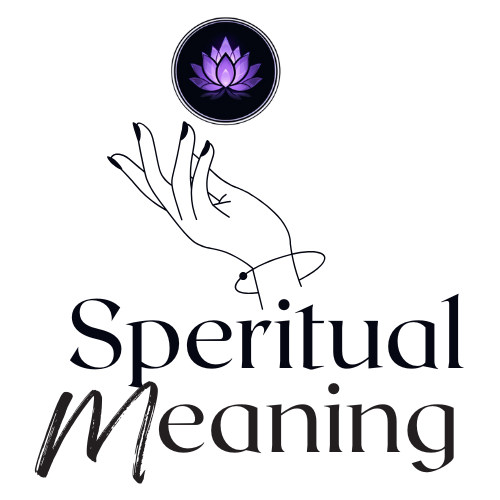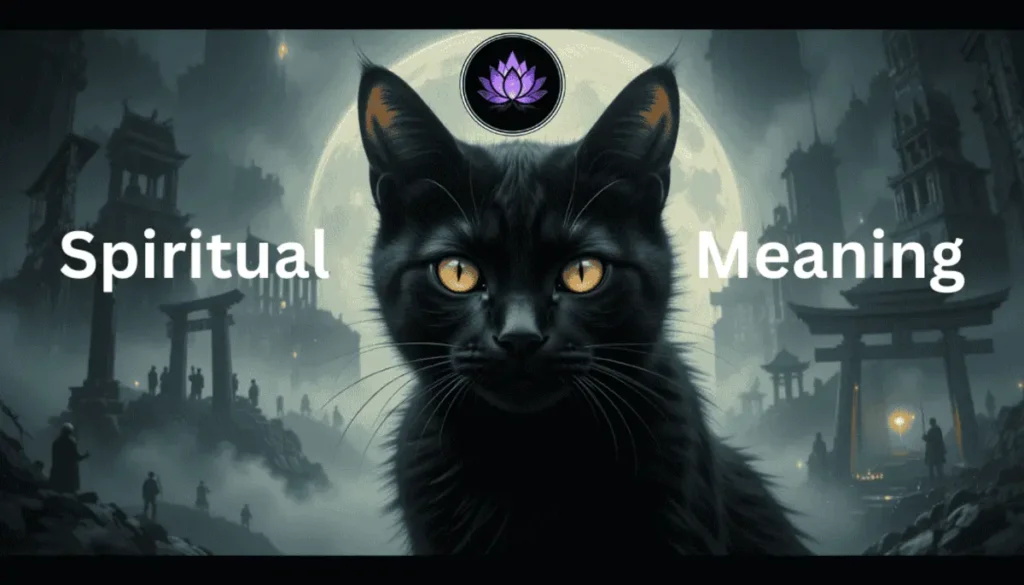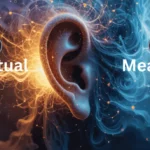Black cats, shrouded in mystique, have danced through human folklore as both omens and guardians. Their sleek silhouettes have sparked reverence and fear, weaving a tapestry of spiritual symbolism across civilizations.
This article delves into the lesser-known spiritual meaning of black cat and practices surrounding these enigmatic felines, exploring their roles as cosmic guides, protectors, and mirrors of the soul. From ancient temples to modern dreamscapes, we unravel the dualities that make black cats timeless symbols of mystery and transformation.
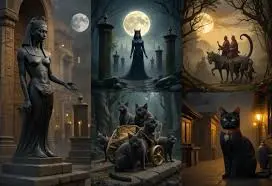
Cultural Perspectives on Black Cat Spirituality:
- Ancient Egypt: Bastet, the lioness goddess of home and fertility, was often depicted as a black cat. Killing one was punishable by death, and families kept black cats to invoke her blessings. When a household cat died, mourners shaved their eyebrows in grief.
- Celtic Lore: The fairy realm’s “Cait Sidhe,” a spectral black cat with a white chest, was believed to steal souls. Families offered milk to appease it during Samhain, fearing it would curse their dead.
- Norse Mythology: Freyja, the goddess of love, rode a chariot pulled by two gray cats—symbols of independence. Black cats were seen as her nocturnal messengers, guiding warriors to Valhalla.
- Japan: The “Nekomata,” a mythical black cat with a forked tail, was thought to manipulate the dead. Yet, black Maneki-neko figurines ward off evil, inspired by a legend where a cat’s raised paw saved a temple from lightning.
- Islamic Tradition: Prophet Muhammad cherished his cat Muezza, leading to a cultural reverence for cats. Black cats were considered neutral, though some legends linked them to jinn shapeshifters.
- Medieval Europe: Pope Gregory IX’s papal bull linked black cats to Satan, fueling witch trials. Yet, British sailors kept them on ships for luck, believing they’d avert storms.
- Scotland: A stray black cat on your porch heralded wealth. Brides were gifted black cats to ensure prosperous marriages.
- Hinduism: Shashthi, the protector of children, rides a black cat. harming cats was taboo, as they were seen as her earthly envoys.
- Native American Tribes: The Cherokee viewed black cats as weather spirits, while the Ojibwe saw them as mediators between worlds.
- Voodoo/Hoodoo: In New Orleans, black cat bones were used in protective mojo bags, while their presence in rituals symbolized spiritual crossroads.
Interpreting Black Cat Encounters:
1. Seeing a Black Cat:
The sight of a black cat carries layered symbolism shaped by cultural narratives. In Sicily, a sneezing black cat is considered an omen of imminent wealth, rooted in the belief that the cat’s breath carries blessings from benevolent spirits. This tradition may stem from ancient Roman associations between sneezing and divine messages. Conversely, English folklore warns that encountering a black cat, especially one that stares intently, signals impending betrayal.
This fear intensified during the witch trials, when black cats were thought to be witches’ spies. However, the true spiritual message lies in your intuitive reaction. If the encounter evokes calm, it may signify protection; if unease arises, it could mirror subconscious fears needing attention. In Japanese culture, a black cat seen near a sickbed is believed to absorb negative energy, acting as a silent healer.
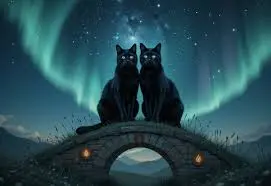
2. Seeing Two Black Cats:
In Norse mythology, the goddess Freyja’s chariot was drawn by two gray cats, Hófvarpnir and Þjálfi, embodying duality—strength and grace, action and intuition. Spotting two black cats may signal a need to reconcile opposing forces in your life, such as logic versus emotion or tradition versus innovation.
Celtic lore adds that paired cats represent the balance between the physical and spirit worlds. A lesser-known Welsh tale speaks of two black cats guarding a fairy portal; their appearance warns of a crossroads where choices will ripple across realities. Modern mystics interpret this encounter as a nudge to meditate on decisions, as your path may soon fork dramatically.
3. Seeing a Black Cat in Dreams:
Freud theorized that black cats in dreams symbolize repressed femininity or intuition, reflecting societal constraints on women’s autonomy. Jung, however, viewed them as archetypes of the “shadow self,” urging integration of hidden traits. In Japanese legend, the bakeneko (supernatural cat) appears in dreams to deliver cryptic guidance.
One story tells of a samurai who dreamed of a black cat leading him through a labyrinth; upon waking, he avoided an ambush by altering his route. In Haitian Vodou, dreaming of a black cat signals communication with ancestral spirits, often ancestors who practiced magic. Such dreams may also warn of deceit—Medieval Arabic dream dictionaries link black cats to hidden enemies.
4. A Black Cat Visiting Your Home
Scottish tradition holds that a black cat arriving at your doorstep heralds prosperity, tied to the belief that the Cait Sidhe—a fairy cat—blesses generous households. Families would leave cream and bread to honor it, ensuring fertility and abundance. Conversely, Haitian Vodou interprets a black cat’s visit as an ancestor returning in feline form to deliver urgent messages.
In Turkey, a stray black cat entering your home is seen as a test of hospitality; refusing it risks inviting nazar (the evil eye). A 19th-century Irish manuscript recounts a widow who sheltered a black cat during a storm; the cat later revealed itself as a land spirit, gifting her a fertile plot of land.
5. A Black Cat Running in Front of Your Car
A Devon legend tells of a coachman spared from a cliffside crash when a black cat darted before his horses, startling them into halting. This tale birthed the belief that black cats intervene to prevent disaster. Modern interpretations suggest such encounters signal a need to slow down or reassess your path.
In Mexican folklore, animals crossing roads are messengers from Mictlán (the underworld), urging reflection on mortality. Truckers in the American South share stories of black cats appearing before near-collisions, viewing them as guardian spirits. Psychologists propose these moments trigger heightened awareness, acting as subconscious “wake-up calls” to avoid reckless decisions.
6. A Black Cat Crossing Your Path
While Western superstition deems this unlucky, Irish lore claims a crossing black cat neutralizes curses, especially if it pauses mid-stride. This stems from the belief that cats see and disrupt malicious energy fields. In India, a black cat crossing left-to-right is auspicious, aligning with the sun’s trajectory, while right-to-left warns of obstacles.
Slavic traditions advise spitting over your left shoulder three times to negate bad luck, a ritual tied to warding off demons. Metaphysically, crossing paths with a black cat symbolizes imminent transformation—like the cat’s fluid movement, you’re urged to adapt rather than resist change.
7. Black Cats as Twin Flame Symbols:
A Roma legend recounts star-crossed lovers cursed into black cat forms, destined to reunite across lifetimes. Spotting a black cat during emotional upheaval may signal your twin flame’s proximity or the need for inner union. In alchemy, black cats represent the coniunctio oppositorum (fusion of opposites), mirroring the twin flame journey of merging shadow and light.
A Persian Sufi parable describes a mystic whose meditation on a black cat’s eyes revealed his soul’s mirror image. Twin flame encounters with black cats often coincide with synchronicities—repeated numbers or songs—hinting at cosmic realignment.
8. When a Stray Black Cat Chooses You:
Celtic lore warns that rejecting a stray black cat risks invoking the Cait Sidhe’s wrath, inviting misfortune for seven years. Conversely, offering food or shelter binds the fairy cat to your protection. In Baltic traditions, a stray black cat choosing your home signifies the favor of Ragana (a witch goddess), who rewards kindness with prophetic visions.
Anecdotes from the Great Depression tell of families saved from starvation by stray black cats who led them to hidden food stores. Biologists note that cats gravitate toward empathetic humans, suggesting such encounters may reflect your energy’s openness to spiritual reciprocity.
Messages and Lessons from Black Cats:
Black cats embody paradoxes—omens and guardians, witches and healers. They teach that shadows hold wisdom: a cat’s nocturnal prowess mirrors our ability to navigate darkness with intuition. Their historical vilification and veneration reflect humanity’s dual capacity for fear and reverence.
In embracing the black cat’s mystery, we confront societal projections—seeing them as “bad luck” often reveals our unprocessed anxieties. Spiritually, they urge authenticity; their unapologetic presence in folklore, despite persecution, symbolizes resilience. By aligning with their energy, we learn to trust unseen guidance and transform fear into curiosity.
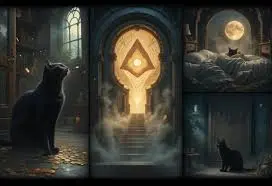
Black Cats in Spiritual Practices:
- Amulets: Obsidian, a volcanic glass linked to protection, is carved into cat shapes to channel Bastet’s energy. In 12th-century Persia, soldiers carried obsidian cat charms to deflect evil on battlefields.
- Meditation: Visualizing a black cat during third-eye meditation enhances clairvoyance. Tibetan monks use this practice to access past-life memories, believing cats traverse time.
- Rituals: Placing a black cat figurine on Samhain altars honors ancestors, as Celts believed cats escorted spirits to the afterlife. Modern witches incorporate cat fur (ethically sourced) in spell bags for stealth and agility.
- Dream Journals: Recording feline symbols helps decode the subconscious. A 1920s study revealed patients drawing black cats before breakthroughs in therapy, symbolizing repressed creativity.
- Festivals: Egypt’s Festival of Bast included releasing temple cats into city streets; their paths were interpreted as divine maps for the coming year.
- Divination: The Ojibwe observed black cats’ interactions with wind direction to predict storms. A cat washing its face signaled clear skies, while restless pacing foretold rain.
| Practice | Purpose | Cultural Origin |
|---|---|---|
| Obsidian Amulets | Deflect curses, enhance courage | Ancient Persia |
| Third-Eye Meditation | Unlock psychic visions | Tibetan Buddhism |
| Samhain Offerings | Ancestor communication | Celtic Paganism |
| Dream Symbol Analysis | Reveal hidden desires | Early 20th-century Psychology |
| Bastet Festivals | Invoke fertility, community harmony | Ancient Egypt |
| Weather Divination | Predict natural cycles | Ojibwe Tradition |
Conclusion:
Black cats are enigmatic guides straddling myth and reality. Their encounters and rituals invite us to dance with mystery, question dogma, and reclaim our intuitive power. Whether as Bastet’s avatars or fairy spies, their legacy whispers: The darkest paths often lead to the brightest revelations.
